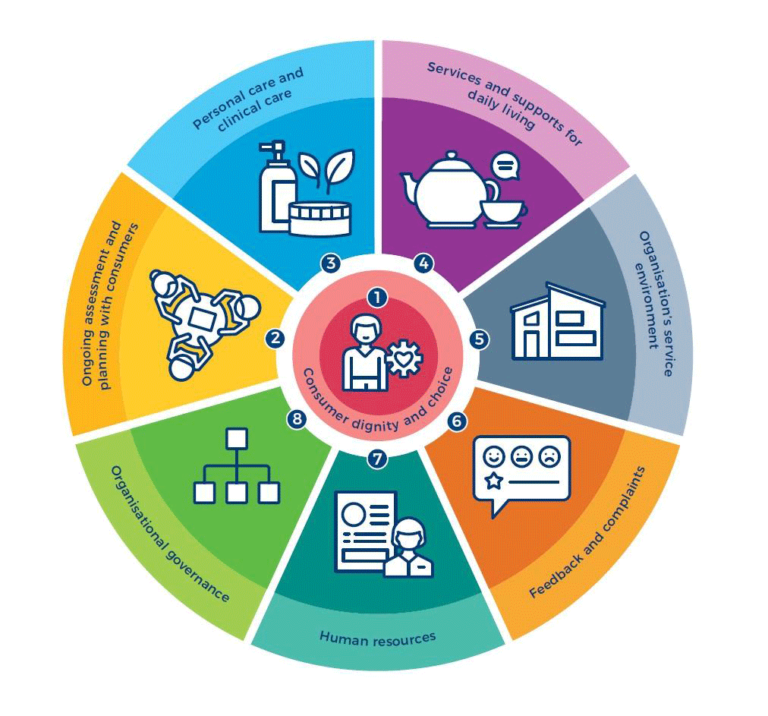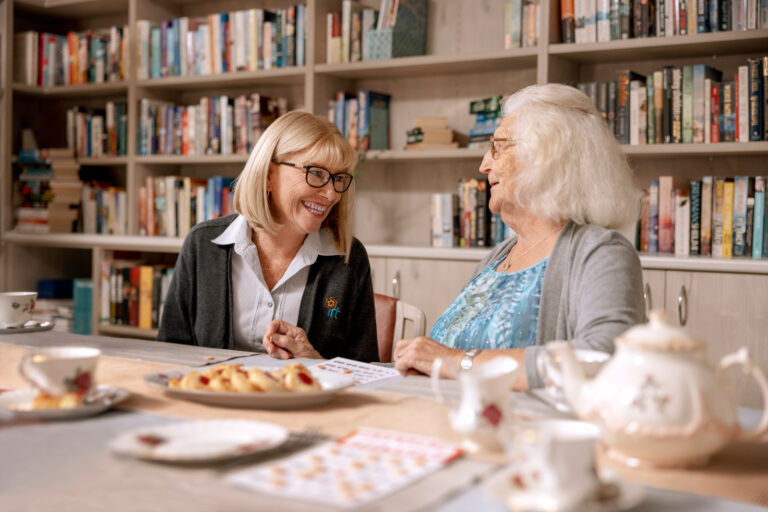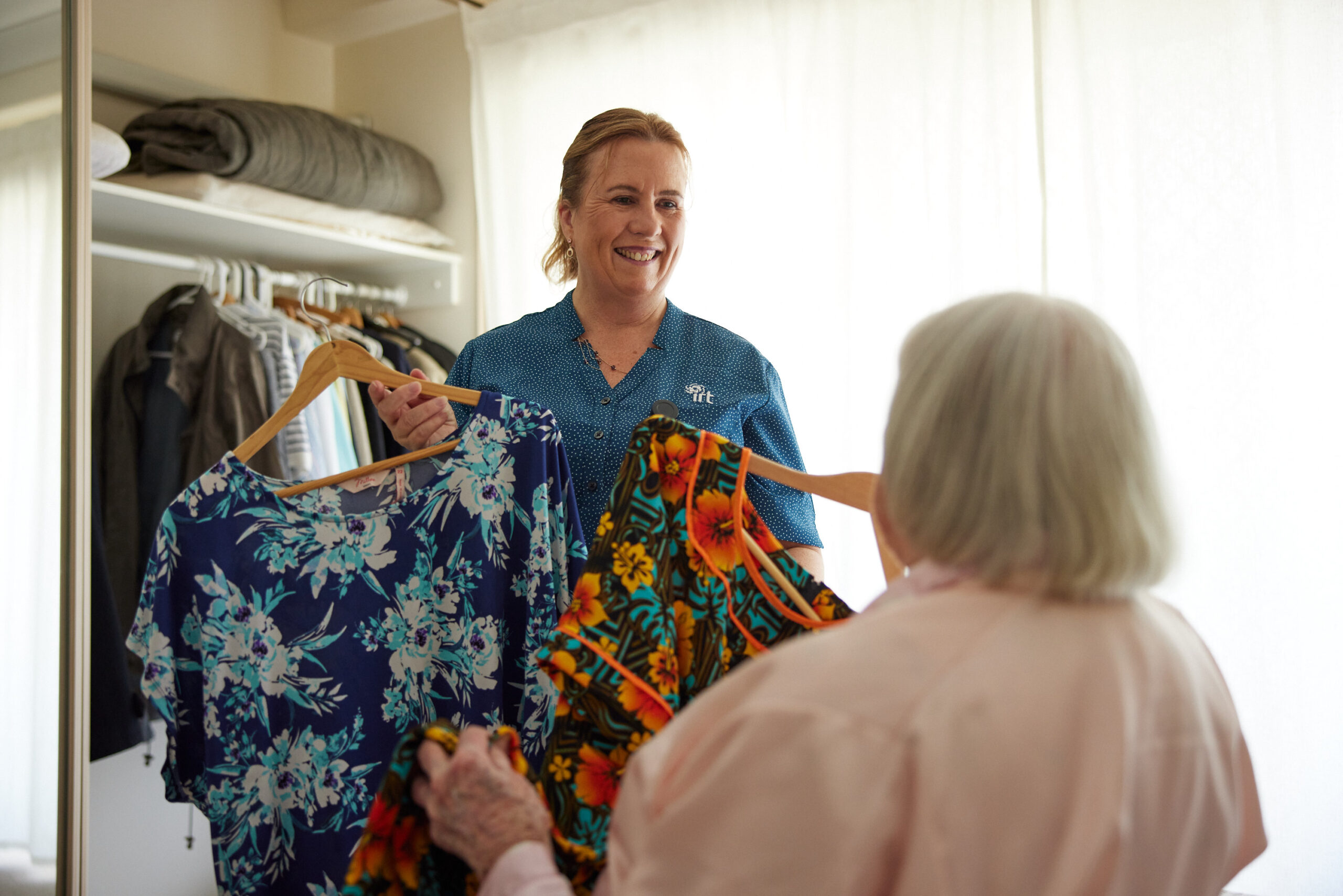What are the Aged Care Quality Standards?
The eight standards are designed to empower older Australians and ensure all aged care providers deliver high quality care and services.

The Aged Care Quality Standards define what good care should look like for people living in residential aged care centres or receiving care and services in their own homes. They were developed by the Australian Government, in consultation with the aged care sector, and came into effect on 1 July 2019.
The eight standards are designed to empower older Australians and ensure all aged care providers deliver high quality care and services.
The Aged Care Quality and Safety Commission is responsible for assessing and monitoring government-funded aged care services against the Quality Standards.
Here are the eight Standards and what they mean for you.
1. Consumer dignity and choice
Aged care providers must cultivate and maintain a culture of inclusion and respect, support people to exercise choice and independence, and respect people’s privacy. Residents and customers are supported to make decisions about their own care, take risks, and exercise choice.
What this means for you: You are treated with dignity and respect, and supported to maintain your identity. You can make informed choices about your care and services, and live the life you choose.
Example: Ben lived alone for nearly 10 years before moving into an aged care centre. Things that were important to him were going to the races on Saturdays and meeting up with other regulars and friends at his local pub. The staff involve Ben in meeting to understand how to safely assess his needs, goals and preferences, and give him the opportunity to involve friends or family members. The outcome of the assessment is a tailored plan that includes arrangements for safe transport to and from the races and pub at an agreed time so that he can still live the life he chooses.
2. Ongoing assessment and planning
Initial and continuous assessment and planning for care and services must be undertaken in close collaboration with the resident or customer. Their needs, goals and preferences should underpin the assessment, planning and provision of care.
What this means for you: You are a partner in ongoing assessment and planning that helps you get the care and services you need for your health and wellbeing.
Example: Olivia has been receiving home care services for several years. She has dementia and her needs have gradually increased, but she is capable and wants to continue living semi-independently for now. Olivia’s family ask the aged care provider to add laundry, ironing and bed-making to their duties. The staff who look after her believe this is unnecessary and risks making Olivia unhappy and affecting her confidence. The main priorities are Olivia’s safety, wellbeing and respecting her wish to keep doing her daily tasks. Staff meet with Oliva to talk about these issues. Olivia agrees to a small increase in staff supervision so she can continue doing these activities herself. Staff also explain the plan to Olivia’s family and they all agree to review the situation again in three months.
3. Personal care and clinical care
Providers promise to provide safe and effective personal care, clinical care, or both, in accordance with the resident or customer’s needs, goals, values and preferences. The care and services are best practice to optimise health and wellbeing.
What this means for you: You get personal care, clinical care, or both, that is safe and right for you.
Example: Bob feels happy and safe with the care he’s receiving because he knows when his condition changes or health deteriorates, the aged care provider has a process for communicating and escalating any concerns. Staff also provide Bob and his nominated representative information on how to minimise the spread of infections, such as handwashing, and the influenza vaccination is also offered to him each year.
4. Services and support for daily living
Residents and customers are provided with safe and effective services and supports for daily living that supports their independence, health, wellbeing and overall quality of life. This includes food services, domestic assistance, and recreational and social activities.
What this means for you: You get the services and supports for daily living that are important for your health and wellbeing and that enable you to do the things you want to do.
Example: Dorothy was a lifesaver for many years and loves going to the beach to watch the waves. She now lives in an aged care centre and often speaks about these memories with staff. Dorothy’s Lifestyle Manager knows how important this is for her mental wellbeing, and therefore plans regular outings to the local beach so Dorothy can feel the sand under her toes and reminisce on her past with staff. Dorothy looks forward to these outings as they support her to feel connected and engaged in a meaningful experience that she likes.

5. Organisation’s service environment
An organisations service environment is safe and comfortable and facilitates the resident or customer’s independence, function and enjoyment. The environment is easy to navigate and understand, safe, clean, comfortable, well-maintained, and allows people to move freely.
What this means for you: You feel you belong and you’re safe and comfortable with the care you are receiving and the care environment you are in.
Example: Ken feels safe and comfortable in the aged care centre where he lives because it’s welcoming, easy to navigate, and there are areas for quiet reflection, religious or cultural practices and private spaces if needed. He also likes that, where agreed, he can move freely indoors and outdoors and have access to natural light and fresh air as required. Ken’s family know he’s safe, and that the aged care centre has security arrangements in line with best practice to protect him where necessary.
6. Feedback and complaints
Aged care providers are committed to listening, seeking and acting on input and feedback from residents, customers, their friends and families, carers and employees. They must have a system in place to resolve complaints that is fair, accessible, prompt and confidential.
What this means for you: You feel safe and you’re encouraged and supported to give feedback and make complaints. You’re engaged in processes to address your feedback and complaints, and appropriate action is taken.
Example: Ron feels supported to give feedback and make complaints at his aged care centre because they have ‘comments, suggestions and complaints’ procedure and he is regularly encouraged to provide his feedback in the comments books, suggestion boxes and resident and family meetings. Comments, suggestions and complaints are managed by Team Leads and Registered Nurses and are progressed to the relevant areas where required (e.g. hospitality services, care services and maintenance services). Staff also conduct a bi-annual customer surveys which are anonymous so that residents can feel supported to speak freely, and provide access to specific advocates, language services and other methods for raising and resolving complaints.
7. Human resources
Organisations must have a workforce that is sufficient, skilled and qualified to provide effective, safe, respectful and quality care and services. All interactions with residents and customers are kind, caring and respectful of each person’s identity, culture and diversity.
What this means for you: You get quality care and services when you need them from people who are knowledgeable, capable and caring.
Example: Peter’s aged care provider has comprehensive education programs and training to ensure staff are provided with up-to-date practices for delivering care and support to Peter and the other care centre residents. Staff are encouraged to give feedback about the training to support how improvements can be made, and are provided with opportunities to continually develop their knowledge and skills.
8. Organisational governance
The governing body of the organisation is accountable for the provision of safe and quality care and services. Information management, continuous improvement, financial governance, workforce governance, regulatory compliance and feedback and complaints systems are all in place.
What this means for you: You are confident the organisation is well run. You’re a partner in improving the delivery of care and services.
Example: Joan’s aged care provider has a skilled and experienced Board of Directors who collectively provide oversight and governance of the organisation and care provided. The Board is accountable for safe and quality care and services, and ensures the organisation has appropriate policies, procedures and systems in place to support this.
Remember
You and your family should feel comfortable to raise questions and issues with your provider if you feel your care isn’t up to standard. If you don’t feel comfortable talking about these issues with your aged care provider, you can contact the Commission on 1800 951 822

Does your loved one need support?
IRT has been supporting older Australians and their families with compassionate care for more than 50 years with aged care centres in NSW, Qld and the ACT. If your loved one needs warm and personalised care you can trust, we'd be more than happy to help.
Find out moreSubscribe to our newsletter
You may also like
Creating an aged care resume with no experience
In this guide we will explain what an aged care resumé is, share tips on how to write a strong one and provide an aged…
Downsizing your home for retirement: where to begin
Have you been thinking about downsizing your home? We help you make sense of this life-changing decision that can reap so many benefits as you…


